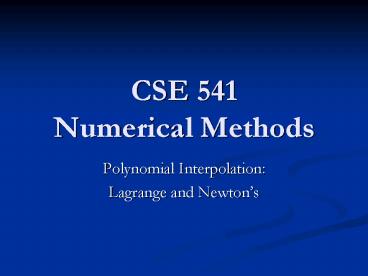CSE 541 Numerical Methods - PowerPoint PPT Presentation
1 / 22
Title:
CSE 541 Numerical Methods
Description:
For example least squares fitting. 8/2/09. 6. OSU/CSE 541. Interpolation. Assumptions: ... Least-squares. Error minimization. 8/2/09. 9. OSU/CSE 541. Polynomial ... – PowerPoint PPT presentation
Number of Views:29
Avg rating:3.0/5.0
Title: CSE 541 Numerical Methods
1
CSE 541Numerical Methods
- Polynomial Interpolation
- Lagrange and Newtons
2
Data Interpolation
- Problem
- Given A list of data points xi, fi
- Goal Evaluate the function in between the xis
- Solutions???
- Nearest value
- Average between neighboring values
- Find a function that models or fits
(approximates?) the data points - Local vs global information
3
Interpolation
- Data from experimental/observational measurements
- Classic gravity drop location changes with time
- Pressure varies with depth
- Wind speed varies with time
- Temperature varies with location
- Census data
What was the population at 1964?
- The relationship looks linear
- Global information (trends)
4
Science, Engineering, Statistics, etc.
- Scientific method (Also Engineering)
- Identify the underlying relationship in your data
(patterns/trends) - Deal with noise in the data
- Make predictions about the behavior of a process
- Not extrapolation!
- Remember distributions in statistics
- Tools used in social science, political science,
etc.
5
Regression vs Interpolation
- Pretty confident
- There is a polynomial relationship
- Little/no scatter
- Find an expression that passes exactly
- through all the points
- This function is an interpolant
- Unsure about the relationship
- Data looks scattered
- Maybe noisy data?
- Find an expression that captures the trend
- Minimize some measure of the error
- over all the points
- For example least squares fitting
6
Interpolation
- Assumptions
- No error in the data
- Round-off is assumed to be negligible
- We dont know the underlying function f (x)
- Given n1 points xi, fi, x0,x1xi,xn xj gt
xj-1 - Spacing may or may not be even
- All xi are distinct
- Interpolation
- Develop a simple function g(x) that
- Approximates f (x)
- Passes through all the points xi (i.e., an
interpolant) - Evaluate f (xt) where x0 lt xt lt xn
7
Taylors Series
- Why not use a Taylor Series for interpolation?
- Interpolates at the point of expansion c
- Approximation gets worse further away from c
- It may not interpolate at other points
- Need f (c), f (c), f (c),
- We would want an interpolant at several f (c)s
8
Modeling Choices
- How do we choose the simple function g(x)???
- Polynomials
- Splines
- Trigonometric functions (Data looks periodic)
- Fourier Transform representations
- Least-squares
- Error minimization
9
Polynomial Interpolation
- Why are polynomials nice functions?
- Defines a line very easily (a linear
relationship) - Easily definable derivatives
10
Existence Theorem
- Wierstrass Approximation Theorem
- Does not say how well the polynomial approximates
a function - What degree polynomial do we use?
- Weaker Theorem
- ò f(x) p(x)dx lt e
- But, we have existence of a polynomial
11
Existence and Uniqueness
- Consider our data set of n 1 points yif(xi) at
distinct points x0,x1xi,xn - In general, there is a unique polynomial
interpolant gn(x) of at most degree n - What about uniqueness?
- Assume uniqueness for now and well prove it later
12
Polynomial Interpolation
- How do we find gn(x)?
- Take n 3, so x0, y0, x1, y1, x2, y2, x3,
y3 - Just solve, right?
- a0 a1x0 a2x02 a3x03 y0
- a0 a1x1 a2x12 a3x13 y1
- a0 a1x2 a2x22 a3x23 y2
- a0 a1x3 a2x32 a3x33 y3
- Express this as a matrix problem Ax b? Solve
for A. - This may not be easy to solve if it is an
ill-conditioned system - Large degree polynomials when n is large
13
Lagrange Polynomials
- Construct a polynomial with the following form
- A linear combination of the sample points
14
Constant Interpolation
- Take n 0,
x0
15
Linear Interpolation
- Take n 1
Blending functions
x0
x1
16
Lagrange Polynomials
- Take n 2, quadratic polynomial
- L0(x), L1(x), and L2(x)
- The third quadratic has roots at x0 and x1 and a
value equal to the function data at x2. - P(x0) 0
- P(x1) 0
- P(x2) f2
- The first quadratic has roots at x1 and x2 and a
value equal to the function data - at x0.
- P(x0) f0
- P(x1) 0
- P(x2) 0
- The second quadratic has roots at x0 and x2 and a
value equal to the function data at x1. - P(x0) 0
- P(x1) f1
- P(x2) 0
- Adding them all together, we get the
interpolating quadratic polynomial, such that - P(x0) f0
- P(x1) f1
- P(x2) f2
x0
x2
x1
17
Newton Interpolation
- Consider our data set of n 1 points yif (xi)
at distinct points x0,x1xi,xn - Note, the notation for the divided difference is
reverse from what is presented in the textbook
18
Interpolation
- Constant interpolation
- pn(x) f(x0)
- Linear interpolation
x0
x1
slope
19
Quadratic Interpolation
- Three data points
roots
Basis (support) for the interval
20
Newton Interpolation
We have a recursive definition
Divided Differences
21
Newton Interpolation
- The recursion formula
- The quadratic term
Divided Differences
22
Invariance Theorem
- The order of the data points does not matter
- Though, the data points must be distinct
- Hence, the divided difference f x0, x1, , xk
is invariant under all permutations of the xis































